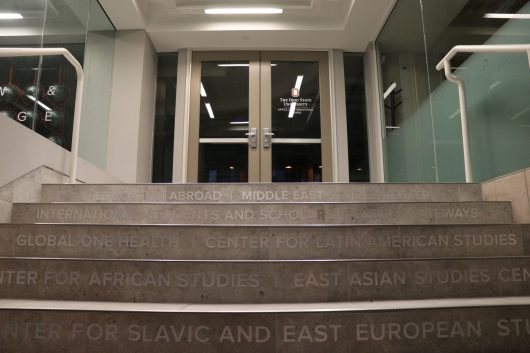
Ohio State Office of International Affairs in the Enarson Classroom Building. Credit: Jack Westerheide | Former Photo Editor
Jacob Chang said he was not planning to return home to China for the entire year.
However, his plans were in jeopardy when Ohio State President Michael V. Drake sent out an email detailing the university’s plan to move out all students from residence halls and transition to online classes in an effort to protect the university from the spread of the coronavirus, officially named COVID-19 by the World Health Organization.
“First thing popped in my head was definitely panicking because, as an international student, I don’t have a lot of housing resources,” Chang, a second-year in psychology and political science, said.
International students studying in the United States are typically required by law to live inside the city limits of their university and take at least 12 credit hours of in-person classes to ensure they remain in the state. Otherwise, their nonimmigrant student status, which allows them to study in the U.S., could be revoked, according to the Department of Homeland Security.
The U.S. Student and Exchange Visitors Program announced on Monday that requirements would be relaxed to allow international students to take online courses and return home after several universities, including Ohio State, moved classes online and asked students to return to their permanent residences.
However, for many of Ohio State’s 6,239 international students, returning home might not be an option.
Ohio State released an exemption form for domestic and international students to petition to remain living in on-campus residences, and these petitions will be evaluated on a case-by-case basis, university spokesperson Dave Isaacs said. The exact residence halls where students will be allowed to stay have not yet been identified, Isaacs said.
Decisions regarding the petitions will be released within 72 hours of submission, according to the petition form.
Aayush Patel, a second-year in information systems and an international student from India, said he can continue to live on-campus and work as a resident advisor for the remainder of the semester.
Chang said he is moving into an apartment with his friend after several students texted him offering him off-campus housing until May.
Chang, vice president of the International Student Council, said having close friends within the domestic community is not the case for many international students.
“A lot of international students tend to hang out with people within their own community and most international students live on-campus because they don’t have a house in the U.S.,” Chang said.
Chinese international students make up 67 percent of international students with 4,192 students at the university, according to Ohio State’s 15th-day enrollment report.
For Chinese students, returning home means returning to the country where the virus was first detected, according to the World Health Organization. There are currently more than 80,000 cases and 3,000 deaths of COVID-19 in China, according to the World Health Organization.
Chang said when he didn’t have housing secured, it created lots of stress for his family.
“Staying here is probably a better option for my own safety, for my GPA and overall my academic success, but at the same time it’s a lot of emotional stress because we don’t have emotional support,” Chang said.
Flying back may be too expensive for some students. For Chinese students, a plane ticket home would cost between $700 and $4,000, according to Google Flights.
China requires a 14-day quarantine for all travelers in an effort to contain the virus, according to the International Air Transport Association. There are similar quarantine requirements for several other countries including Israel, India, Uganda and New Zealand.
Chang also said if he returned to China he would not be able to access essential websites because of internet censorship by the Chinese government.
“We won’t be able to access Google. We won’t be able to access Gmail,” Chang said. “Our U.S. phone number won’t work, so there’s a chance we won’t be able to get Duo Mobile.”
Duo Mobile is the dual-factor authentication service students, staff and faculty use to log into Ohio State accounts.
Indian international students are the second-highest population of international students after students from China with 591 students, according to the enrollment report.
Yatin Khanna, a fourth-year in mechanical engineering and an international student from India, said the university is in “uncharted territory.”
“Going back is not practical because most of the classes will still be at the same time even though they are online, and the time-zone difference between India and the U.S. would make it difficult to take those classes at that time,” Khanna said.
A plane ticket to India would cost between $1,100 and $1,900, according to Google Flights.
Chang, who is also the deputy director of diversity and inclusion of Undergraduate Student Government and marketing director of Chinese Students and Scholars Society, said his organization’s executive boards are trying their best to support their members during this time by contacting embassies, housing and advisors.
Undergraduate Student Government is providing resources such as storage, internet access and food pantries to both international and domestic students through Twitter and Instagram.
“Domestic students, they can go back home to stay with their family and also they have a place to stay. For me, even I have a place to stay, but I will be by myself,” Chang said.
Beyond the spring semester, the future continues to be uncertain. Ohio State has not released information regarding the status of summer housing, courses or university jobs.
Click here to view our continuing coverage of COVID-19.


